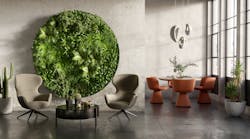ASID Predicts the Year's Top 5 Sustainability Trends
With the spring season comes a reawakening of new life around us and an appreciation for our Earth. Although we recognize Earth Day in April, the rise of sustainability in design ethos has made it important to be earth-friendly all year long. Over the past several years in design, eco-friendly has become eco-chic, as interior design clients and consumers are prioritizing sustainably sourced materials in an effort to reduce our collective carbon footprints. The American Society of Interior Designers has rounded up the top five sustainability trends impacting design in 2023, and their implications for designers:
1. Sustainability as a core value:
Consumers, including home buyers, are favoring businesses and brands that demonstrate a sense of social purpose and a commitment to good stewardship of the planet. ASID found an upward trend amongst consumers placing increasing emphasis on sustainability as a value guiding their purchasing choices, with increasing numbers of consumers saying they are willing to pay a premium for some purchases if they are protecting their environment. ASID’s 2023 Trends Outlook report guides designers through this data and encourages designers to appeal to their clients’ desire to protect the planet, and help them make sustainable choices by sharing knowledge of the environmental impact and cost-benefits of sustainable products and materials.
2. Homeowners’ seek energy efficiency:
In the housing market, ASID’s research found increased demand for homes with energy efficient and sustainable features. As remote work has increased and people are spending more time at home, these considerations take on even more importance. As homeowners look to products that can help reduce energy consumption through all seasons, materials rated highly in longevity, durability and energy efficiency become more appealing.
3. Material choices that connect with the natural world:
Synthetic materials and hard surfaces are giving way to warmer, more fashionable materials, such as natural fabrics, lighter woods, and renewable materials like wool, cotton, bamboo, linoleum, and cork. Responding to consumers’ growing interest in sustainable living, top brands are touting eco-friendly and -responsible products, giving designers a much wider variety of quality products, materials and finishes. As homeowners prioritize more eco-friendly products this can also translate into recyclable, reclaimed and recycled materials used in design and renovations.
4. Wellness is paramount in hospitality:
Hospitality guests are gravitating towards properties that demonstrate a commitment to sustainability and wellness, and in turn, hotels are declaring their commitment to sustainability and wellness by switching to natural materials and incorporating plants into their spaces. Hospitality properties also are starting to use healthier finishes, incorporate more natural light, and provide more access to nature and nature views. To appeal to wellness-minded travelers, the hospitality sector has embraced green and biophilic design, and properties are incorporating these elements into their renovations and remodels. Strategizing the use of eco-friendly products and materials and the addition of elements to improve wellness can provide a huge benefit to the hospitality industry when appealing to consumers wanting to reduce their carbon footprint.
[Related: The 1 Hotel Nashville is an Oasis in the Middle of Music City]
5. Greenwashing persists:
ASID’s research found that greenwashing is creeping into biophilic-designed spaces. The growing use of biophilic design to enhance sustainability and wellbeing in interiors has raised concerns about projects that present a “greenwashed aesthetic” as opposed to following true biophilic practices and principles. Often, organizations will introduce biophilic features such as plants, natural materials and nature views, but not ensure that the materials and finishes, as well as the overall impact of the enhancements, are truly sustainable—not just “green.”
